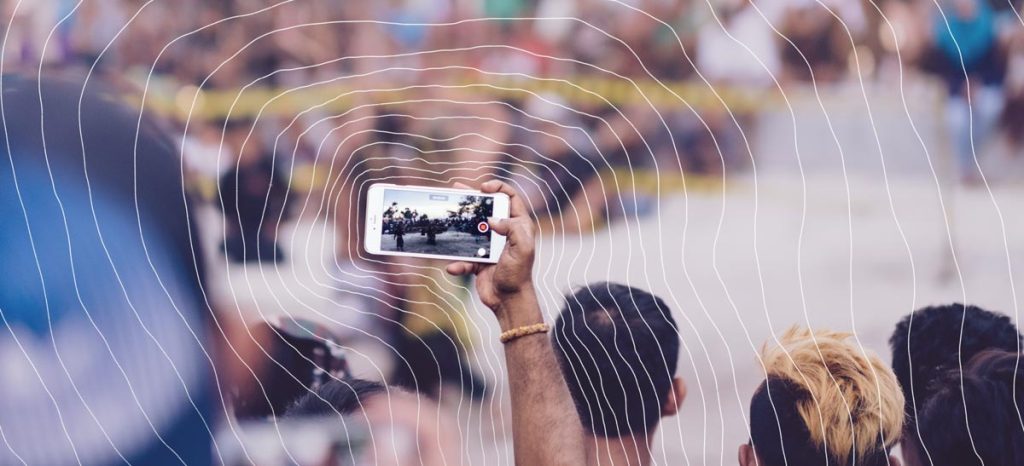Citizen Journalism and Political Protests

From gun violence to mass deportations to sexual misconduct accusations leveled at powerful men, there is no shortage of reasons for the polarized American electorate to take to the streets in protest.
In 2017, the United States saw 8,700 public protests, attracting between 6 million and 9 million participants by the end of the year. Journalists are often at the frontlines, documenting these history-making movements, which presents its own set of professional challenges. Also in 2017, about half of all press freedom incidents, such as arrests of journalists and searches and seizures of equipment, happened at protests.
Protests present a unique setting for journalists: Three prongs of the public’s First Amendment rights—freedom of speech, freedom of press, freedom of petition—come together at every public protest or rally. At the same time, the rise of social media has irrevocably changed the roles of news reporters and has also enabled citizen journalists, who take risks to document highly contentious environments in order to keep the public informed.
“If you never take risks, you’ll rarely write a story of consequence,” said Greg Munno, a Communications@Syracuse faculty member and assistant professor of magazine, news and digital journalism at the S.I. Newhouse School of Public Communications, with expertise in civic engagement and data journalism.
The field of journalism is rife with risks. Understanding rights, while balancing these risks, can make all the difference to citizen journalists and aspiring reporters.
What Is a Citizen Journalist?
The concept of citizen journalism, according to the Poynter Institute , spans 11 variations of work, from something as simple as letting readers comment on digital articles to a seamless integration of reporting and publishing a story.
“Citizen journalism can play a really important role in making sure that the world as we know it gets sufficiently covered,” Munno said.
What makes someone a citizen journalist?

OBSERVING
—not participating—at the scene of a community event.

ABSTAINING
from letting personal views or opinions change the angle of the information.

DOCUMENTING
legally obtained information in a public space, just like a professional journalist.

SHARING
that information with their community or with a news organization.
This first-person documentation can be crucial to the survival of the journalism field as more news outlets face increasingly tight travel budgets.
“To tell these stories as a citizen journalist requires curiosity and a sense of adventure, as well as willingness to remain at least somewhat detached from the event itself,” Munno noted.
As soon as a person begins participating in a rally or protest—chanting, throwing rocks, provoking others, generally causing a scene—they lose the credibility of an objective observer.
What Are the Rights of the Press at Protests?
Historically, the U.S. Supreme Court has ruled that members of the press have the same First Amendment protections as citizens in public spaces like sidewalks and streets, where speech and protests can be expected. But there’s a misconception that journalists have special privileges during protests, said Barbara Fought, a Communications@Syracuse faculty member and an associate professor of broadcast and digital journalism at Newhouse, with expertise in First Amendment law.
“We don’t really want government saying who is a journalist and who isn’t,” Fought said. “Because then the government could be discriminating against certain types of journalists,” which would violate the First Amendment.
This opens up the opportunity for citizens to act as reporters when they see, record and share information about events that happen in public spaces. However, not every protest video uploaded to social media automatically makes someone a reporter.
Though the Constitution predates digital media, the Bill of Rights is still interpreted to protect professional reporters and citizen journalists when they are documenting and publishing information.
Legal Rights That Protect Newsgathering
ELECTRONIC RECORDINGS IN PRIVATE:
State laws vary in requiring one or all parties’ consent when a private conversation is being recorded. This applies to tape recordings, phone calls and hidden cameras. Reporters can find the statutes for their state in the Reporter’s Recording Guide (PDF, 1.3 MB) from the Reporters Committee for Freedom of the Press.
ACCESSING PUBLIC SPACES:
Reporters generally have the same rights as other private citizens to access or assemble in a public space, barring a time, place and manner restriction from law enforcement. They also have the right to record people and events in these public spaces. Some government-owned property is not considered open to the public, including military bases, prisons or battlefields.
JURIES AND GRAND JURIES:
While potential jurors are not legally prohibited from speaking to members of the press before or after a trial, individual judges may tell jurors they are free to refuse interviews. Court orders can prohibit jurors from speaking to journalists during trial proceedings and deliberations, a violation punishable with jail time.
PUBLIC RECORDS:
The Freedom of Information Act allows any person to request unclassified public information from a federal government agency or institution. A few common sense exceptions include security plans, names of undercover officers or private medical information.
SEARCH AND SEIZURE:
The Fourth Amendment of the Constitution protects personal belongings and private spaces from being searched or seized by law enforcement without a warrant. That includes recording devices, tripods, notebooks and other newsgathering equipment.
INVASION OF PRIVACY:
Shield laws are state-level case laws or statutes that protect reporters from having to disclose confidential sources or unpublished information. There is no federal shield law, but 49 states have enacted variations of this protection.
LEAKED INFORMATION:
Shield laws often protect journalists who report about and reshare leaked information, but they do not protect entities who originally leaked the information. Reporters are expected to cooperate with federal law enforcement agencies or prosecutors who need the information for investigations or security purposes.
These rights only protect the press from government recourse or prosecution as long as other laws are not being broken. In a privately owned space like social media platforms, individual codes of conduct apply. Additionally, law enforcement officials are not obligated to allow anyone to cross into public space that is marked off for criminal investigation or to allow assembly without a permit.
The top reasons journalists get arrested (PDF, 548 KB) include trespassing, public disturbance and misconduct. Reporters have to decide in the moment whether a story is worth the burden of legal action; these cases are often won by reporters or their news organizations.
“Can you continue recording while standing where the officer asks you to stand?” Fought said. “Is it worth standing your ground? That’s a conversation to have with your news organization.”
If an arrest is made and the reporter is part of a news organization, then they’ll be able to rely on the organization to help sue or pay bail. If they’re not affiliated with an organization—which is likely the case for most citizen journalists—they’ll have to seek counsel on their own.
In 2017, the Columbia Journalism Review detailed a long-standing series of altercations between police and reporters, highlighting the paradox of relying on law enforcement as a source of public information while simultaneously acting as a check on government power.
Working with law enforcement to establish trust can be the start of building relationships between institutions based on respect, even for citizen journalists not affiliated with a known paper or outlet.
Building Relationships with Law Enforcement

NEWS ORGANIZATIONS
- Communicate with local police departments when sending reporters to cover a rally.
- Discuss expectations or safety concerns.
- Encourage reporters to build rapport with community members.

REPORTERS
- Work candidly with law enforcement officers.
- Build trust with sources like officers, public defenders and elected officials.
- Review ethical standards with editors before sharing information.

CITIZEN JOURNALISTS
- Observe physical boundaries set by police.
- Comply with legal requirements of a permit to assemble.
- Contribute story ideas or social media to news outlets.
Going Viral: Social Media Content as News Media
The rise of social media has made it easier for outlets to publish user-generated content recorded by citizen journalists. Social media has also helped ensure marginalized perspectives get the recognition they deserve. Police brutality has largely been covered by citizen journalism and brought light to civil rights issues through footage that may never otherwise be part of the news media.
While these videos and accounts can often be valuable contributions to stories, they can also come with serious ramifications if used inappropriately. When covering protests and demonstrations, news organizations have to adapt their newsgathering strategies to account for social media without falling prey to unverified information.
“Social media has certainly prompted most newsrooms to think through their policies about using materials,” said Fought. “Almost every time we have some major national news incident, somebody tries to punk the media or spread wrong information purposely or ignorantly.”
Verifying and Using Social Media Content
- Get two sources to confirm the accuracy of the content.
- Contact the person who published the content and ask for permission to share it.
- Consider privacy of any minors depicted or quoted in the content.
- Have conversations with editors about ethics when sharing graphic content.
- Adhere to legal guidelines about defamation and invasion of privacy.
- Refrain from resharing defamatory content or illegally obtained information.
- Avoid projecting or sharing personal opinions of any reporters on the scene.
“One of our biggest challenges as an industry,” Munno said, “is that people don’t make a distinction between opinion, commentary and reported information.”
The process of aggregating and resharing information increases the risk of introducing new errors or agendas along the way. Resharing unverified, unethical content can result in legal liabilities for the reporter and publication, so it’s important to spend extensive time verifying sources.
One way that reporters can work with concerned citizens and activists in their community is to engage with readers in the comments or on social media to give context around stories, gauge public opinion and find sources for local coverage.
“Let your community be your assigning editors,” Munno said. “Write stories about the issues they want to know about.”
Creating and consuming the news is not an exact binary, especially in the age of digital convergence where news stories evolve and take new shapes as stories develop.
Munno believes that news organizations can leverage the role of citizens on the ground as a way of supplementing their traditional reporters. The outcome, he said, will be “producing a more robust news report that better informs the community and ideally leads to better outcomes in our democracy and society.”
Citation for this content: Communications@Syracuse, Syracuse University’s online master’s in communications


